2008 CHRYSLER TOWN AND COUNTRY airbag
[x] Cancel search: airbagPage 12 of 531
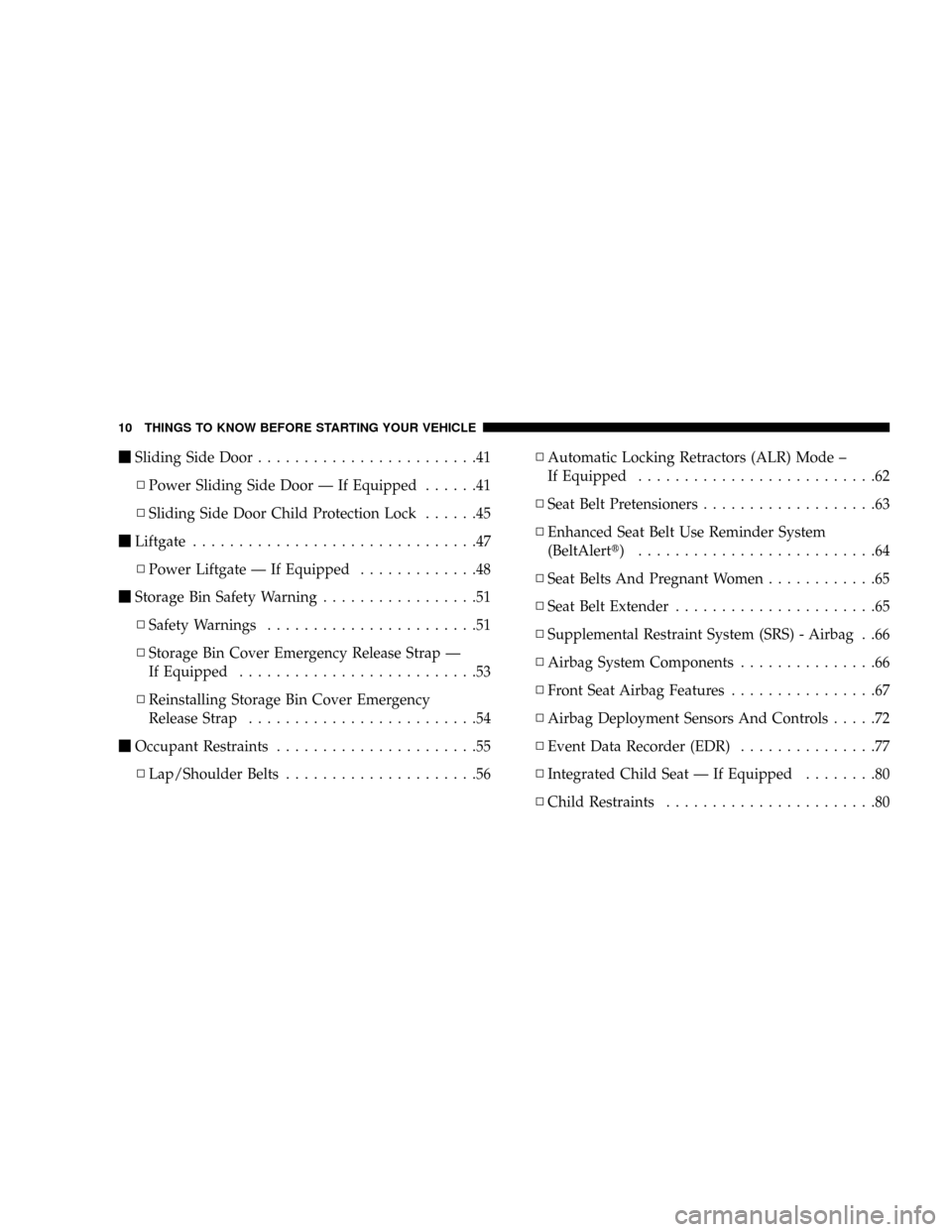
mSliding Side Door........................41
NPower Sliding Side Door Ð If Equipped......41
NSliding Side Door Child Protection Lock......45
mLiftgate...............................47
NPower Liftgate Ð If Equipped.............48
mStorage Bin Safety Warning.................51
NSafety Warnings.......................51
NStorage Bin Cover Emergency Release Strap Ð
If Equipped..........................53
NReinstalling Storage Bin Cover Emergency
Release Strap.........................54
mOccupant Restraints......................55
NLap/Shoulder Belts.....................56NAutomatic Locking Retractors (ALR) Mode ±
If Equipped..........................62
NSeat Belt Pretensioners...................63
NEnhanced Seat Belt Use Reminder System
(BeltAlertt) ..........................64
NSeat Belts And Pregnant Women............65
NSeat Belt Extender......................65
NSupplemental Restraint System (SRS) - Airbag . .66
NAirbag System Components...............66
NFront Seat Airbag Features................67
NAirbag Deployment Sensors And Controls.....72
NEvent Data Recorder (EDR)...............77
NIntegrated Child Seat Ð If Equipped........80
NChild Restraints.......................80
10 THINGS TO KNOW BEFORE STARTING YOUR VEHICLE
Page 57 of 531
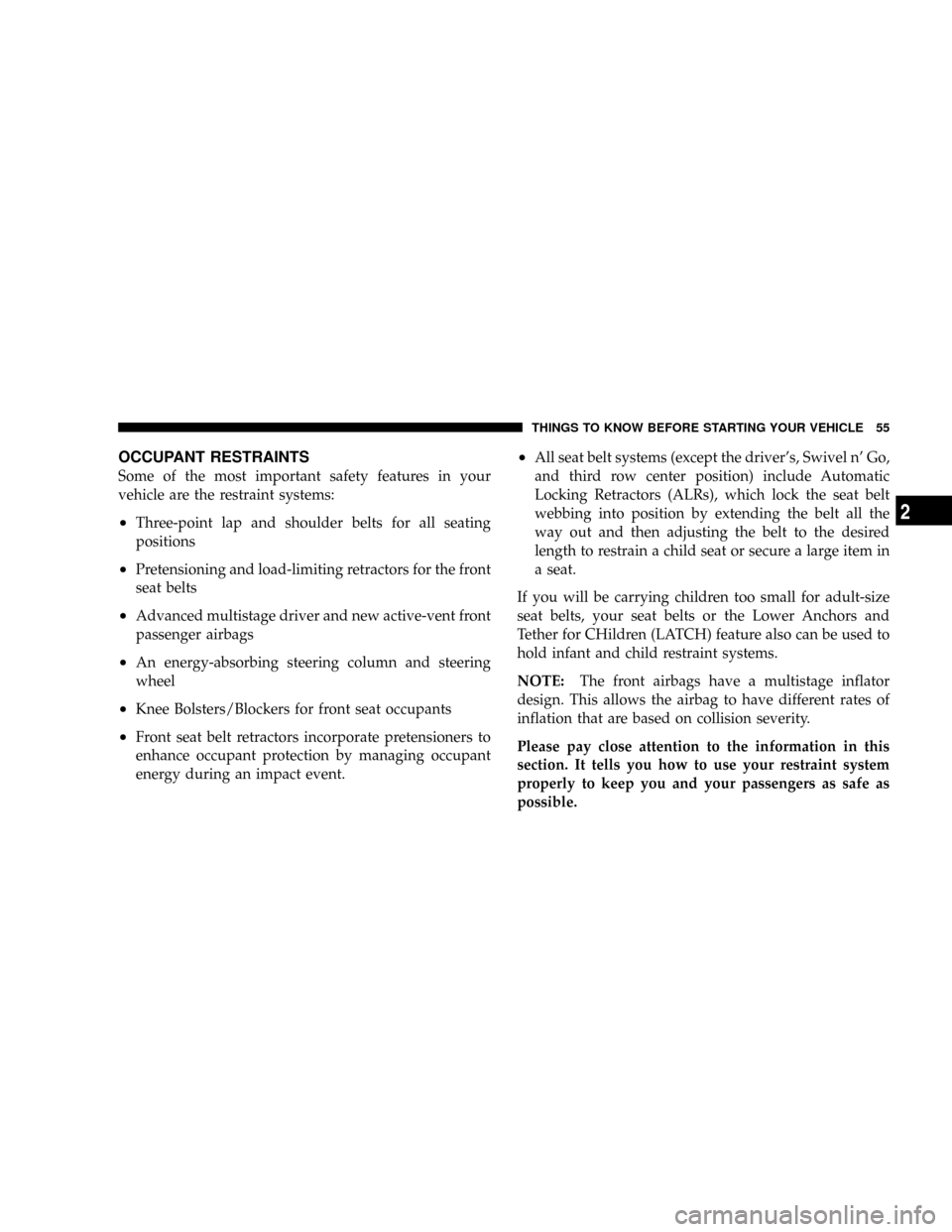
OCCUPANT RESTRAINTS
Some of the most important safety features in your
vehicle are the restraint systems:
²Three-point lap and shoulder belts for all seating
positions
²Pretensioning and load-limiting retractors for the front
seat belts
²Advanced multistage driver and new active-vent front
passenger airbags
²An energy-absorbing steering column and steering
wheel
²Knee Bolsters/Blockers for front seat occupants
²Front seat belt retractors incorporate pretensioners to
enhance occupant protection by managing occupant
energy during an impact event.
²All seat belt systems (except the driver's, Swivel n' Go,
and third row center position) include Automatic
Locking Retractors (ALRs), which lock the seat belt
webbing into position by extending the belt all the
way out and then adjusting the belt to the desired
length to restrain a child seat or secure a large item in
a seat.
If you will be carrying children too small for adult-size
seat belts, your seat belts or the Lower Anchors and
Tether for CHildren (LATCH) feature also can be used to
hold infant and child restraint systems.
NOTE:The front airbags have a multistage inflator
design. This allows the airbag to have different rates of
inflation that are based on collision severity.
Please pay close attention to the information in this
section. It tells you how to use your restraint system
properly to keep you and your passengers as safe as
possible.
THINGS TO KNOW BEFORE STARTING YOUR VEHICLE 55
2
Page 65 of 531

When To Use The Automatic Locking Mode
Use The Automatic Locking Mode anytime a child safety
seat is installed in a passenger seating position. Children
12 years old and younger should be properly restrained
in the rear seat whenever possible.
How To Use The Automatic Locking Mode
1. Buckle the combination lap/shoulder belt.
2. Grasp the shoulder portion and pull downward until
the entire belt is extracted.
3. Allow the belt to retract. As the belt retracts, you will
hear a clicking sound. This indicates the safety belt is
now in the automatic locking mode.
How To Disengage The Automatic Locking Mode
Disconnect the combination lap/shoulder belt and allow
it to retract completely to disengage the automatic lock-
ing mode and activate the vehicle sensitive (emergency)
locking mode.
Seat Belt Pretensioners
The seat belts for both front seating positions are
equipped with pretensioning devices that are designed to
remove slack from the seat belt in the event of a collision.
These devices improve the performance of the seat belt
by assuring that the belt is tight about the occupant early
in a collision. Pretensioners work for all size occupants,
including those in child restraints.
NOTE:These devices are not a substitute for proper seat
belt placement by the occupant. The seat belt still must be
worn snugly and positioned properly.
The pretensioners are triggered by the Occupant Re-
straint Controller (ORC). Like the front airbags, the
pretensioners are single use items. After a collision that is
severe enough to deploy the airbags and pretensioners,
both must be replaced.
THINGS TO KNOW BEFORE STARTING YOUR VEHICLE 63
2
Page 68 of 531

Supplemental Restraint System (SRS) - Airbag
This vehicle has airbags for both the driver and front
passenger as a supplement to the seat belt restraint
systems. The driver's front airbag is mounted in the
center of the steering wheel. The passenger's front airbag
is mounted in the instrument panel, above the glove
compartment. The words SRS AIRBAG are embossed on
the airbag covers.
NOTE:The front airbags are certified to the Federal
regulations that allow less forceful deployment.
The front airbags have a multistage inflator design. This
may allow the airbag to have different rates of inflation
that are based on collision severity and occupant size.
This vehicle may also be equipped with Supplemental
Seat Side Airbag Inflatable Curtains (SABIC) to protect
the driver, front, and rear passengers sitting next to awindow. If the vehicle is equipped with SABIC air bags,
they are located above the side windows and their covers
are also labeled: SRS AIRBAG.
NOTE:Airbag covers may not be obvious in the interior
trim; but they will open to allow airbag deployment.
Airbag System Components
The airbag system consists of the following:
²Occupant Restraint Controller (ORC)
²Airbag Telltale Light
²Driver Airbag
²Front Passenger Airbag
²Front and Side Impact Sensors
²Steering Wheel and Column
²Instrument Panel
66 THINGS TO KNOW BEFORE STARTING YOUR VEHICLE
Page 69 of 531
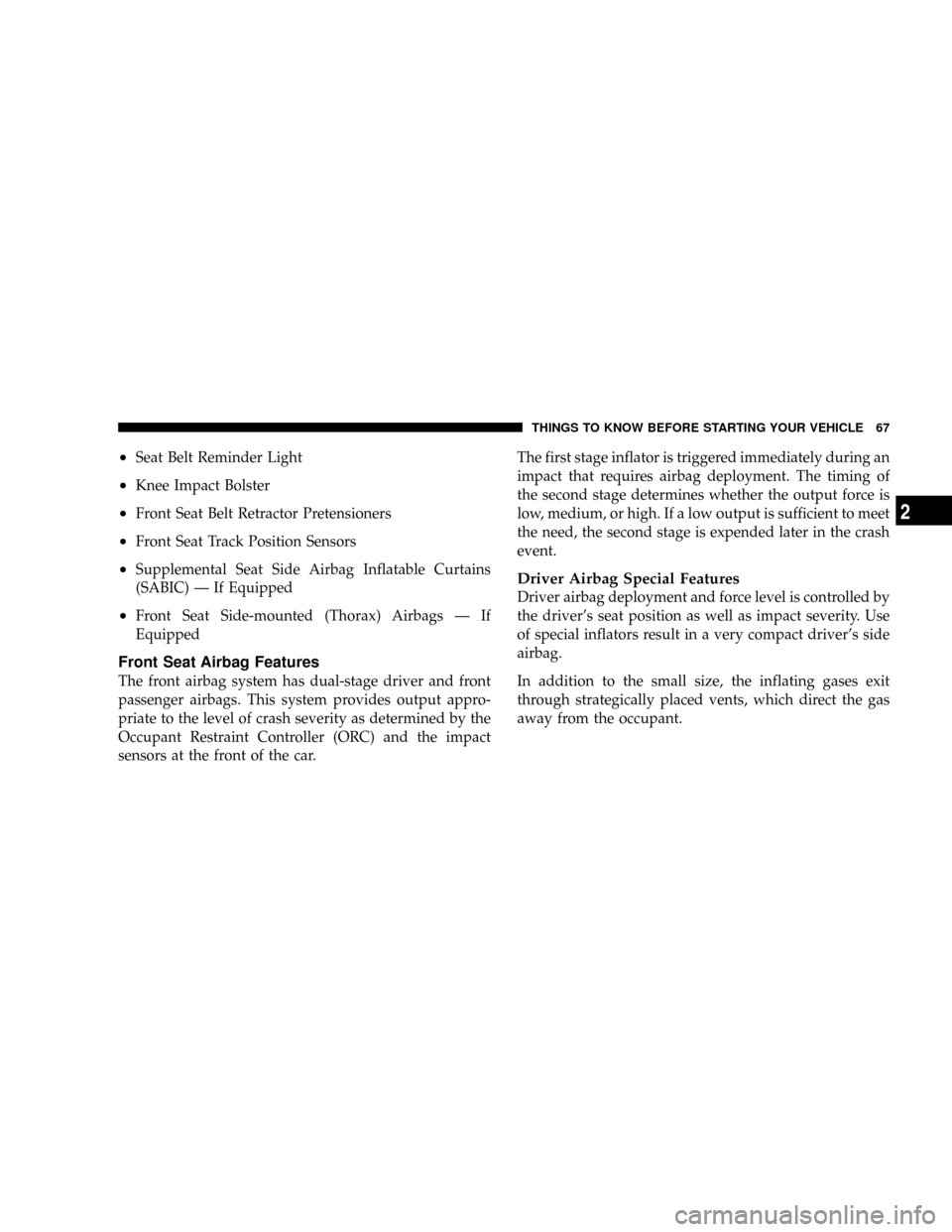
²Seat Belt Reminder Light
²Knee Impact Bolster
²Front Seat Belt Retractor Pretensioners
²Front Seat Track Position Sensors
²Supplemental Seat Side Airbag Inflatable Curtains
(SABIC) Ð If Equipped
²Front Seat Side-mounted (Thorax) Airbags Ð If
Equipped
Front Seat Airbag Features
The front airbag system has dual-stage driver and front
passenger airbags. This system provides output appro-
priate to the level of crash severity as determined by the
Occupant Restraint Controller (ORC) and the impact
sensors at the front of the car.The first stage inflator is triggered immediately during an
impact that requires airbag deployment. The timing of
the second stage determines whether the output force is
low, medium, or high. If a low output is sufficient to meet
the need, the second stage is expended later in the crash
event.
Driver Airbag Special Features
Driver airbag deployment and force level is controlled by
the driver's seat position as well as impact severity. Use
of special inflators result in a very compact driver's side
airbag.
In addition to the small size, the inflating gases exit
through strategically placed vents, which direct the gas
away from the occupant.
THINGS TO KNOW BEFORE STARTING YOUR VEHICLE 67
2
Page 70 of 531

Front Passenger Airbag Special Features
A new active venting front passenger airbag is designed
to reduce the risk of occupants who may be out of
position by the use of active vents positioned on each
side of the airbag.
Supplemental Front Seat-Mounted Thorax Side
Airbags Ð If Equipped
Front seat-mounted side (Thorax) airbags provide en-
hanced protection and work together with supplemental
Side Airbag Inflatable Curtains (SABIC) to help protect
an occupant during a side impact. The seat-mounted side
airbag is marked with an airbag label sewn into the
outboard side of the seat.
When the airbag deploys, it opens the seam between the
front and side of the seat's trim cover. Each airbag
deploys independently, that is a left side impact deploys
the left airbag only and a right-side impact deploys only
the right airbag.
Thorax Airbag Label
68 THINGS TO KNOW BEFORE STARTING YOUR VEHICLE
Page 71 of 531
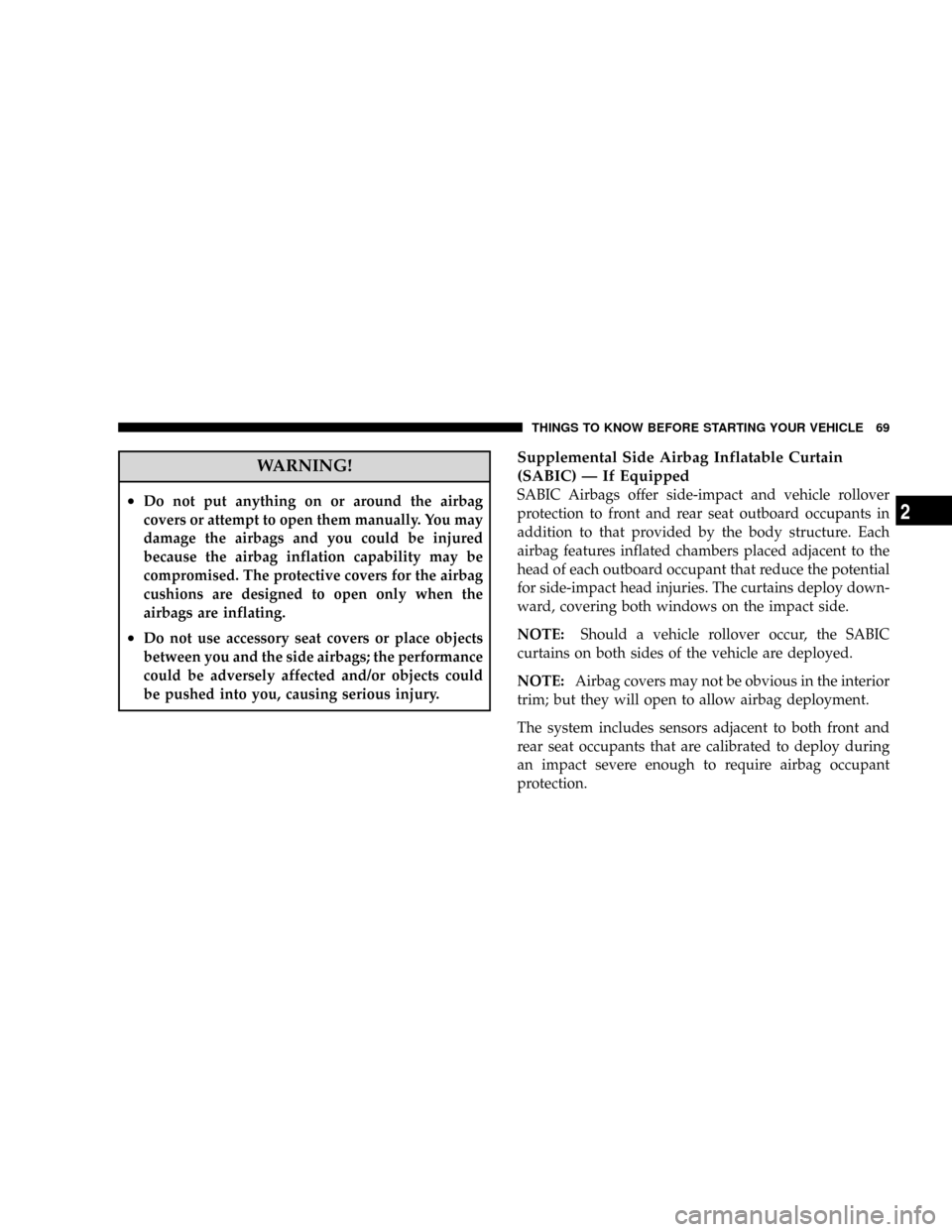
WARNING!
²Do not put anything on or around the airbag
covers or attempt to open them manually. You may
damage the airbags and you could be injured
because the airbag inflation capability may be
compromised. The protective covers for the airbag
cushions are designed to open only when the
airbags are inflating.
²Do not use accessory seat covers or place objects
between you and the side airbags; the performance
could be adversely affected and/or objects could
be pushed into you, causing serious injury.
Supplemental Side Airbag Inflatable Curtain
(SABIC) Ð If Equipped
SABIC Airbags offer side-impact and vehicle rollover
protection to front and rear seat outboard occupants in
addition to that provided by the body structure. Each
airbag features inflated chambers placed adjacent to the
head of each outboard occupant that reduce the potential
for side-impact head injuries. The curtains deploy down-
ward, covering both windows on the impact side.
NOTE:Should a vehicle rollover occur, the SABIC
curtains on both sides of the vehicle are deployed.
NOTE:Airbag covers may not be obvious in the interior
trim; but they will open to allow airbag deployment.
The system includes sensors adjacent to both front and
rear seat occupants that are calibrated to deploy during
an impact severe enough to require airbag occupant
protection.
THINGS TO KNOW BEFORE STARTING YOUR VEHICLE 69
2
Page 72 of 531
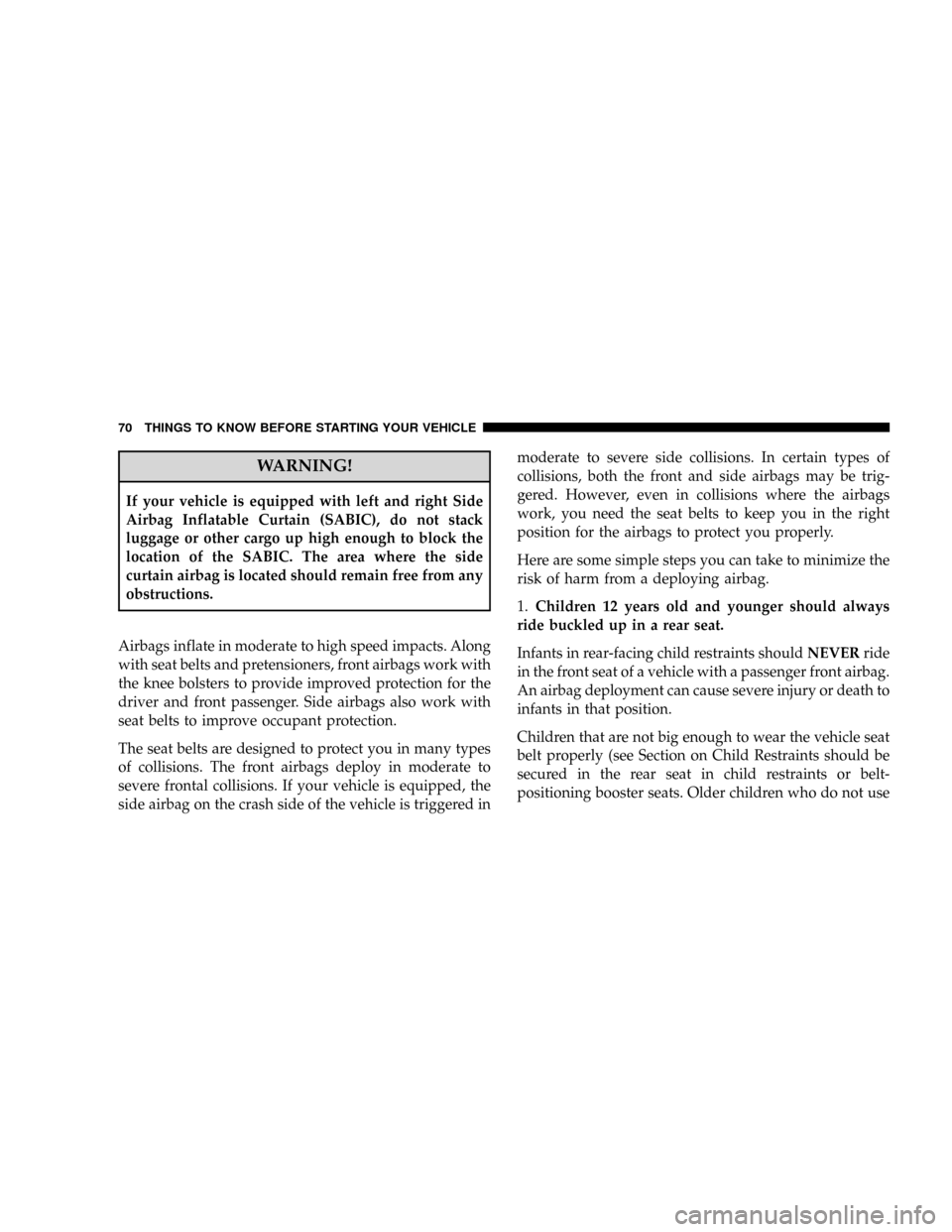
WARNING!
If your vehicle is equipped with left and right Side
Airbag Inflatable Curtain (SABIC), do not stack
luggage or other cargo up high enough to block the
location of the SABIC. The area where the side
curtain airbag is located should remain free from any
obstructions.
Airbags inflate in moderate to high speed impacts. Along
with seat belts and pretensioners, front airbags work with
the knee bolsters to provide improved protection for the
driver and front passenger. Side airbags also work with
seat belts to improve occupant protection.
The seat belts are designed to protect you in many types
of collisions. The front airbags deploy in moderate to
severe frontal collisions. If your vehicle is equipped, the
side airbag on the crash side of the vehicle is triggered inmoderate to severe side collisions. In certain types of
collisions, both the front and side airbags may be trig-
gered. However, even in collisions where the airbags
work, you need the seat belts to keep you in the right
position for the airbags to protect you properly.
Here are some simple steps you can take to minimize the
risk of harm from a deploying airbag.
1.Children 12 years old and younger should always
ride buckled up in a rear seat.
Infants in rear-facing child restraints shouldNEVERride
in the front seat of a vehicle with a passenger front airbag.
An airbag deployment can cause severe injury or death to
infants in that position.
Children that are not big enough to wear the vehicle seat
belt properly (see Section on Child Restraints should be
secured in the rear seat in child restraints or belt-
positioning booster seats. Older children who do not use
70 THINGS TO KNOW BEFORE STARTING YOUR VEHICLE